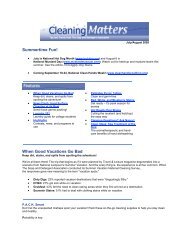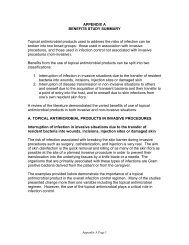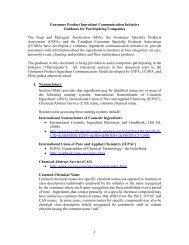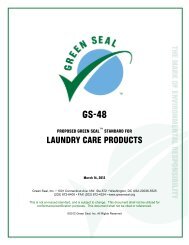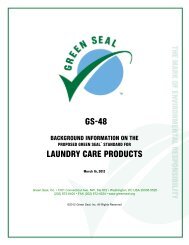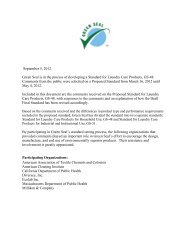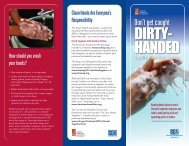subchapter c -- federal hazardous substances act regulations
subchapter c -- federal hazardous substances act regulations
subchapter c -- federal hazardous substances act regulations
Create successful ePaper yourself
Turn your PDF publications into a flip-book with our unique Google optimized e-Paper software.
(18)(i) Any bunk bed (as defined in §<br />
1513.2(c) of this chapter) that does not comply<br />
with the requirements of part 1513 of this<br />
chapter.<br />
(ii) Findings. In order to issue a rule under<br />
Section 3(e) of the Federal Hazardous<br />
Substances Act (FHSA), 15 U.S.C. 1262(e),<br />
classifying a toy or other article intended for<br />
use by children as a <strong>hazardous</strong> substance on<br />
the basis that it presents a mechanical hazard<br />
(as defined in Section 2(s) of the FHSA), the<br />
FHSA requires the Commission to make the<br />
following findings and to include these<br />
findings in the regulation: Bunk beds present a<br />
mechanical hazard; Where a voluntary<br />
standard has been adopted and implemented<br />
by the affected industry, that compliance with<br />
such voluntary standard is not likely to result<br />
in the elimination or adequate reduction of the<br />
risk of injury, or it is unlikely that there will be<br />
substantial compliance with such voluntary<br />
standard; The benefits expected from the rule<br />
bear a reasonable relationship to its costs; and<br />
The rule imposes the least burdensome<br />
requirement that prevents or adequately<br />
reduces the risk of injury for which the rule is<br />
being promulgated. These findings are made<br />
in the Appendix to Part 1513.<br />
(19)(i) Dive sticks, and other similar<br />
articles, that are used in swimming pools or<br />
other water environments for such <strong>act</strong>ivities as<br />
underwater retrieval games or swimming<br />
instruction, and which, when placed in the<br />
water, submerge and rest at the bottom of the<br />
pool. This includes products that are preweighted<br />
to sink to the bottom and products<br />
that are designed to allow the user to adjust the<br />
weight. Dive sticks and similar articles that<br />
come to rest underwater at an angle greater<br />
than 45 degrees from vertical when measured<br />
under the test at § 1500.86(a)(7) and dive<br />
sticks and similar articles that maintain a<br />
compressive force of less than 5-lbf under the<br />
test at § 1500.86(a)(8) are exempt from this<br />
banning rule. Articles that have a continuous<br />
circular shape, such as dive rings and dive<br />
disks are also exempt.<br />
(ii)(A) Findings. In order for the<br />
Commission to issue a rule under section<br />
2(q)(1) of the FHSA classifying a substance or<br />
article as a banned <strong>hazardous</strong> substance, the<br />
Commission must make certain findings and<br />
include these findings in the regulation. 15<br />
U.S.C. 1262(i)(2). These findings are<br />
16 CFR Ch. II (1–1–05 Edition)—proposed modificication – 6/25/06<br />
-- 29 --<br />
discussed in paragraphs (a)(18)(ii)(B) through<br />
(D) of this section.<br />
(B) Voluntary standard. No findings<br />
concerning compliance with and adequacy of a<br />
voluntary standard are necessary because no<br />
relevant voluntary standard addressing the risk<br />
of injury posed by dive sticks has been<br />
adopted and implemented.<br />
(C) Relationship of benefits to costs. The<br />
Commission estimates the potential benefits of<br />
removing <strong>hazardous</strong> dive sticks from the<br />
market to be 2 to 4 cents per dive stick. With<br />
the availability of substitutes and the expected<br />
low cost of modifying dive sticks to conform<br />
to the rule, the Commission anticipates that<br />
necessary changes will be minimal. The<br />
Commission estimates that the costs of the rule<br />
will be no more than 2 to 4 cents per dive<br />
stick. Thus, the Commission finds that there is<br />
a reasonable relationship between the expected<br />
benefits of the rule and its costs.<br />
(D) Least burdensome requirement. The<br />
Commission considered pursuing voluntary<br />
recalls, following a voluntary standard,<br />
requiring labeling or changing the scope of the<br />
rule. A banning rule would be more effective<br />
than case-by-case recalls because the<br />
impalement hazard affects all dive sticks, not a<br />
specific brand or model. Awaiting recalls<br />
would allow these <strong>hazardous</strong> items on the<br />
market until the Commission obtained recalls.<br />
No applicable voluntary standard exists, and<br />
compliance may be low if one did. Although<br />
labeling could help reduce the risk of injuries<br />
from dive sticks, it would be less effective<br />
than a banning rule. It may be difficult for a<br />
label to convey the necessary information at<br />
the time of use. Modifying the scope so that<br />
the rule would only apply to pre-weighted dive<br />
sticks would continue to permit <strong>hazardous</strong><br />
items because the unweighted dive sticks can<br />
easily be weighted to stand vertically at the<br />
bottom of the water. Thus, the Commission<br />
finds that a ban of dive sticks with the<br />
<strong>hazardous</strong> char<strong>act</strong>eristics it has identified is the<br />
least burdensome alternative that would<br />
adequately reduce the risk of injury.<br />
(b) Electrically operated toys and other<br />
electrical operated children’s articles<br />
presenting electrical, thermal, and/or certain<br />
mechanical hazards. Under the authority of<br />
section 2(f)(1)(D) of the <strong>act</strong> and pursuant to<br />
provisions of section 3(e) of the <strong>act</strong>, the<br />
Commission has determined that the following



